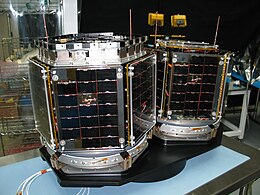Ralphie (satellite)
 | |
| Mission type | Technology |
|---|---|
| Operator | CU-Boulder AFRL STP |
| Mission duration | Failed to orbit |
| Spacecraft properties | |
| Launch mass | 16 kilograms (35 lb) |
| Dimensions | 46 x 30cm (six-sided)[1] |
| Start of mission | |
| Launch date | December 21, 2004 |
| Rocket | Delta IV Heavy |
| Launch site | Cape Canaveral SLC-37B |
| Orbital parameters | |
| Reference system | Geocentric |
| Regime | Low Earth |
| Epoch | Planned |
Ralphie (or 3CS-2) was a satellite, part of the Three Corner Satellite (3CS) project, a three satellite (Sparkie, Ralphie, Petey) student research project. It was designed and built by mostly undergraduate students at the University of Colorado Boulder as part of the Air Force Research Laboratory's University Nanosat Program.[2]
Ralphie was responsible for imaging and End-to-End Data Systems in the 3CS project.
The satellite carries the name of CU Boulder's mascot, Ralphie.
Ralphie was launched on the first launch of the Delta IV Heavy rocket configuration, along with 3CS-1, "Sparkie", but failed to achieve orbit due to a problem with the rocket during launch.[3]
See also[edit]
References[edit]
- ^ "3CSat". Archived from the original on October 16, 2006. Retrieved 21 February 2011.
- ^ Boeing (2004-12-01). "The DemoSat payload". Spaceflight Now. Retrieved 2011-02-18.
- ^ Ray, Justin (2005-03-15). "Delta 4-Heavy investigation identifies rocket's problem". Retrieved 2011-02-18.
